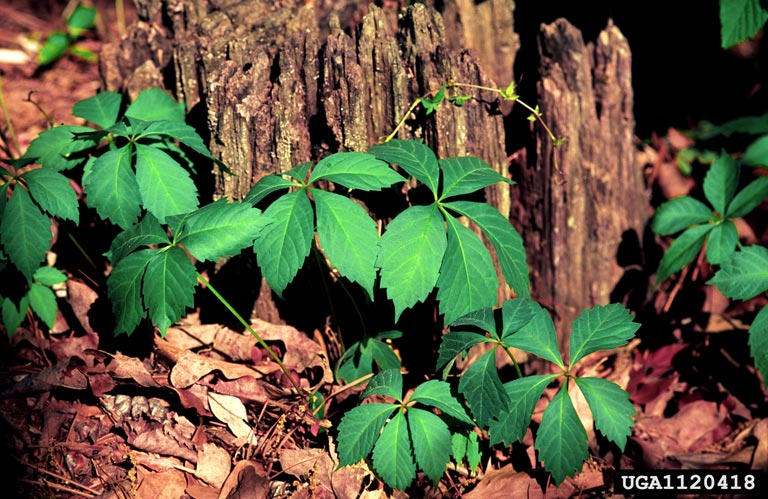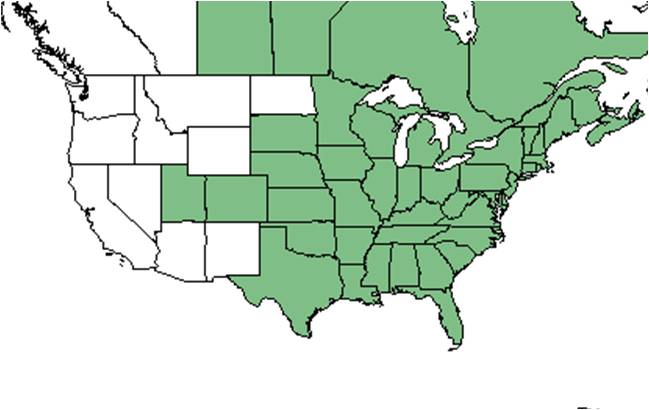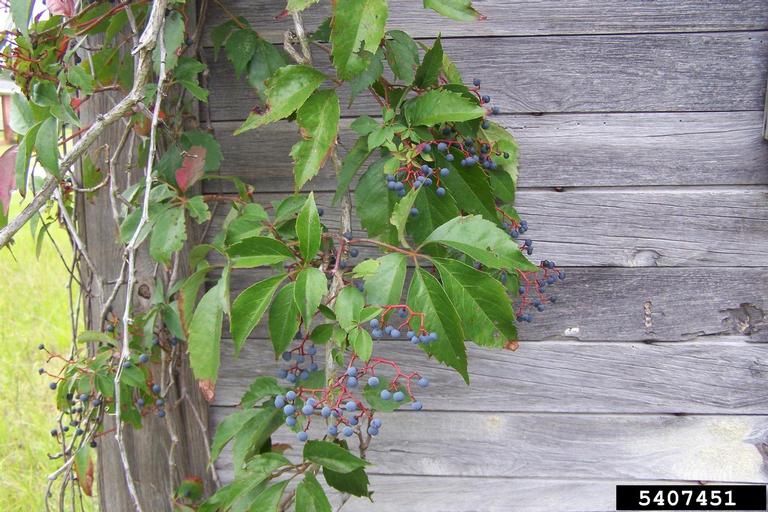Parthenocissus quinquefolia
| Parthenocissus quinquefolia | |
|---|---|

| |
| Photo by James H. Miller & Ted Bodner, Southern Weed Science Society, Bugwood.org | |
| Scientific classification | |
| Kingdom: | Plantae |
| Division: | Magnoliophyta - Flowering plants |
| Class: | Magnoliopsida – Dicotyledons |
| Order: | Rhamnales |
| Family: | Vitaceae |
| Genus: | Parthenocissus |
| Species: | P. quinquefolia |
| Binomial name | |
| Parthenocissus quinquefolia (L.) Planch. | |

| |
| Natural range of Parthenocissus quinquefolia from USDA NRCS Plants Database. | |
Common name: Virginia creeper
Contents
Taxonomic notes
Synonym: Parthenocissus hirsuta (Pursh) Graebner
Description
"High climbing vine with white pith and many tendrils with adhesive disks. Leaves palmately compound, petiolate; leaflets 3-7, usually 5, ovate, elliptic, or obovate, to 15 cm long and 8 cm wide, glabrous, usually pale beneath, occasionally pubescent, acuminate, coarsely serrate, usually above the middle of the blade, base cuneate or oblique, petiolulate. Inflorescence a panicle of cymes. Calyx flat, usually without lobes; petals 5, separate, yellowish green, 2-3 mm long; disk small, adnate to ovary; stamens 5, filaments short; style ca. 0.5 mm long. Drupes black or dark blue, globose, 5-9 mm in diam.; seeds 1-3, lustrous brown, planoconvex, obovoid, 3.5-4 mm long." [1]
Distribution
The range is from Quebec and the Northeastern United States across to Minnesota, south to Texas, Florida, Cuba, Bermuda, and the Bahamas.[2]
Ecology
Phenology
P. quinquefolia has been observed flowering in June and July.[3]Leaves turn orange and red shades. Leaves are lost in cold winter weather. Flowering occurs from January through August in South Florida and April through June to the North. Fruiting occurs from June to November in South Florida and June to September to the North.[4]
Seed dispersal
This species is thought to be dispersed by consumption by vertebrates. [5]
Pollination
The following Hymenoptera families and species were observed visiting flowers of Parthenocissus quinquefolia at Archbold Biological Station: [6]
Apidae: Apis mellifera
Colletidae: Colletes nudus
Halictidae: Augochloropsis anonyma, A. metallica
Megachilidae: Coelioxys sayi, Megachile mendica
Pompilidae: Episyron conterminus posterus, Tachypompilus f. ferrugineus
Vespidae: Mischocyttarus cubensis, Parancistrocerus fulvipes rufovestris, P. perennis anacardivora, Polistes bellicosus, Stenodynerus beameri, Vespula squamosa
Conservation and management
Cultivation and restoration
Photo Gallery
Parthenocissus quinquefolia Photo by Karan A. Rawlins, University of Georgia, Bugwood.org
References and notes
- ↑ Radford, Albert E., Harry E. Ahles, and C. Ritchie Bell. Manual of the Vascular Flora of the Carolinas. 1964, 1968. The University of North Carolina Press. 694. Print.
- ↑ Hall D. 1986The Joy of Weeds-Florida Wildflowers Virginia Creeper Palmetto 6(1):12
- ↑ Nelson, G. PanFlora: Plant data for the eastern United States with emphasis on the Southeastern Coastal Plains, Florida, and the Florida Panhandle. www.gilnelson.com/PanFlora/ Accessed: 12 DEC 2016
- ↑ Hall D. 1986 The Joy of Weeds-Florida's Wildflowers Virginia Creeper Palmetto 6(1):12
- ↑ Kirkman, L. Katherine. Unpublished database of seed dispersal mode of plants found in Coastal Plain longleaf pine-grasslands of the Jones Ecological Research Center, Georgia.
- ↑ Deyrup, M.A. and N.D. 2015. Database of observations of Hymenoptera visitations to flowers of plants on Archbold Biological Station, Florida, USA.
